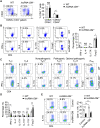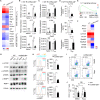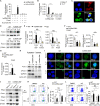lncRNA-GM targets Foxo1 to promote T cell-mediated autoimmunity
- PMID: 35930633
- PMCID: PMC9355365
- DOI: 10.1126/sciadv.abn9181
lncRNA-GM targets Foxo1 to promote T cell-mediated autoimmunity
Abstract
RNA-RBP interaction is important in immune regulation and implicated in various immune disorders. The differentiation of proinflammatory T cell subset TH17 and its balance with regulatory T cell (Treg) generation is closely related to autoimmune pathogenesis. The roles of RNA-RBP interaction in regulation of TH17/Treg differentiation and autoinflammation remain in need of further investigation. Here we report that lncRNA-GM polarizes TH17 differentiation but inhibits iTreg differentiation by reducing activity of Foxo1, a transcriptional factor that is important in inhibiting TH17 differentiation but promoting Treg generation. lncRNA-GM-deficient mice were protected from experimental autoimmune encephalomyelitis. Mechanistically, lncRNA-GM directly binds to cytoplasmic Foxo1, thus inhibiting its activity through blocking dephosphorylation of Foxo1 by phosphatase PP2A to promote Il23r transcription. The human homolog of lncRNA-GM (AK026392.1) also polarizes human TH17 differentiation. Our study provides mechanistic insight into the interaction of lncRNA and transcriptional factor in determining T cell subset differentiation during T cell-mediated autoimmune diseases.
Figures






Similar articles
-
Graded Foxo1 activity in Treg cells differentiates tumour immunity from spontaneous autoimmunity.Nature. 2016 Jan 28;529(7587):532-6. doi: 10.1038/nature16486. Epub 2016 Jan 20. Nature. 2016. PMID: 26789248 Free PMC article.
-
CK2 Controls Th17 and Regulatory T Cell Differentiation Through Inhibition of FoxO1.J Immunol. 2018 Jul 15;201(2):383-392. doi: 10.4049/jimmunol.1701592. Epub 2018 Jun 11. J Immunol. 2018. PMID: 29891553 Free PMC article.
-
Antigen-specific transforming growth factor β-induced Treg cells, but not natural Treg cells, ameliorate autoimmune arthritis in mice by shifting the Th17/Treg cell balance from Th17 predominance to Treg cell predominance.Arthritis Rheum. 2012 Aug;64(8):2548-58. doi: 10.1002/art.34513. Arthritis Rheum. 2012. PMID: 22605463 Free PMC article.
-
MicroRNA-mediated regulation of T helper type 17/regulatory T-cell balance in autoimmune disease.Immunology. 2018 Dec;155(4):427-434. doi: 10.1111/imm.12994. Epub 2018 Sep 10. Immunology. 2018. PMID: 30133700 Free PMC article. Review.
-
Green tea EGCG, T cells, and T cell-mediated autoimmune diseases.Mol Aspects Med. 2012 Feb;33(1):107-18. doi: 10.1016/j.mam.2011.10.001. Epub 2011 Oct 14. Mol Aspects Med. 2012. PMID: 22020144 Review.
Cited by
-
Integrated bioinformatics analysis identifies hub genes and immune regulatory networks in HIV infection.Front Immunol. 2025 Jun 12;16:1600713. doi: 10.3389/fimmu.2025.1600713. eCollection 2025. Front Immunol. 2025. PMID: 40574839 Free PMC article.
-
Inhibition of FoxO1 alleviates polycystic ovarian syndrome by reducing inflammation and the immune response.Funct Integr Genomics. 2024 Jan 8;24(1):6. doi: 10.1007/s10142-024-01284-4. Funct Integr Genomics. 2024. PMID: 38189995
-
miR-132-3p downregulates FOXO1 in CD4+ T cells and is associated with disease manifestations in patients with lupus.J Int Med Res. 2024 Oct;52(10):3000605241286762. doi: 10.1177/03000605241286762. J Int Med Res. 2024. PMID: 39429035 Free PMC article.
-
Regulation of T cell differentiation and function by long noncoding RNAs in homeostasis and cancer.Front Immunol. 2023 Jun 6;14:1181499. doi: 10.3389/fimmu.2023.1181499. eCollection 2023. Front Immunol. 2023. PMID: 37346034 Free PMC article. Review.
-
LncRNA Neat1 targets NonO and miR-128-3p to promote antigen-specific Th17 cell responses and autoimmune inflammation.Cell Death Dis. 2023 Sep 16;14(9):610. doi: 10.1038/s41419-023-06132-0. Cell Death Dis. 2023. PMID: 37716986 Free PMC article.
References
-
- Fugger L., Jensen L. T., Rossjohn J., Challenges, progress, and prospects of developing therapies to treat autoimmune diseases. Cell 181, 63–80 (2020). - PubMed
-
- Chataway J., Tackling progression in multiple sclerosis. Lancet Neurol. 17, 489–491 (2018). - PubMed
-
- Ghoreschi K., Laurence A., Yang X.-P., Tato C. M., McGeachy M. J., Konkel J. E., Ramos H. L., Wei L., Davidson T. S., Bouladoux N., Grainger J. R., Chen Q., Kanno Y., Watford W. T., Sun H.-W., Eberl G., Shevach E. M., Belkaid Y., Cua D. J., Chen W., O’Shea J. J., Generation of pathogenic TH17 cells in the absence of TGF-β signalling. Nature 467, 967–971 (2010). - PMC - PubMed
LinkOut - more resources
Full Text Sources
Molecular Biology Databases
Research Materials
Miscellaneous

